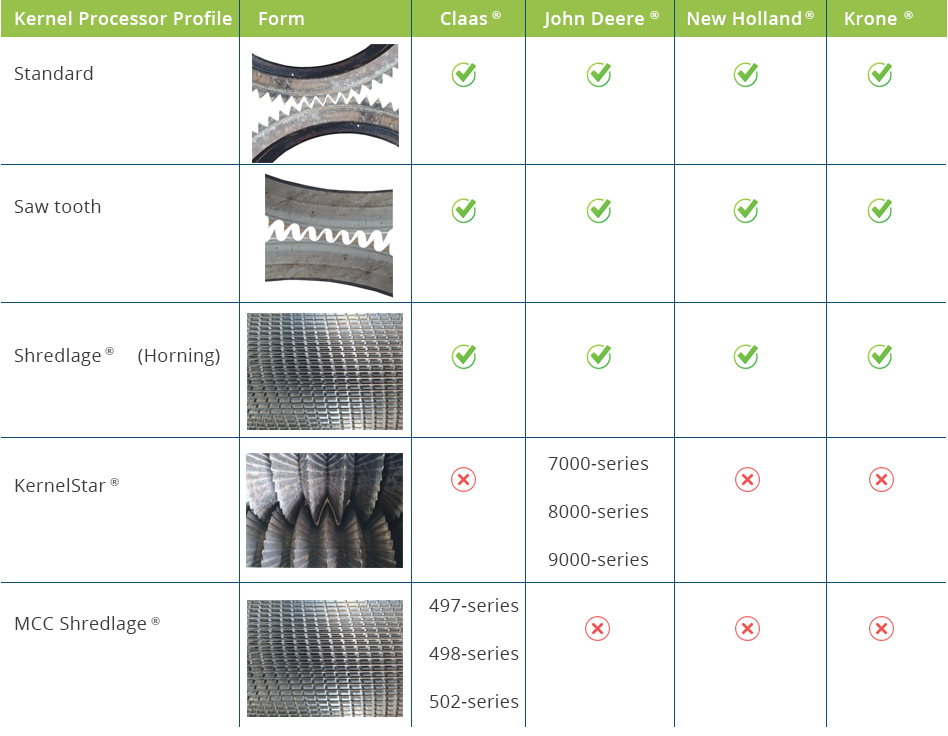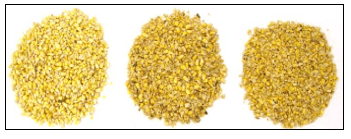Kernel Processor or Corn Cracker
What is a Kernel Processor or Corn Cracker?
Forage harvesters can be equipped with kernel processors / corn crackers to crack corn kernels. Processing can improve kernel digestibility, especially when kernels are mature. Processors also break the cobs increasing cob consumption by the cow. The crushing of the plant improves silo compaction, allowing for increased length of cut. The economic advantage of a kernel processor is dependent on the percent corn silage in the ration, the number of cows being fed corn silage, and the typical speed and timeliness of harvest. Kernel processors are counter-rotating rollers that are intended to crack corn kernels as they pass from the cutterhead to the blower. Kernel processors or Corn Crackers are installed between the cutterhead and the blower. In most forage harvesters, the KP/CC can be quickly removed and replaced with a grass chute for chopping non-cereal crops.
The length of the chopped forage is important, and corn kernels and stalk sections need to be cracked open otherwise they pass through the animal undigested. The patented Shredlage® system from Claas® has been shown to create better silage. This is basically a pair of grooved rollers 2mm apart that rotate at different speeds so the chopped material that passes between them is torn and shredded. The two silver-coloured rollers that crack the corn kernels and stalks to create better silage.
What kind of Kernel Processor or Corn Cracker will fit my Self Propelled Forage Harvester?

What is the adventage of a Kernel Processor or Corn Cracker?
For cows to digest the starch in corn efficiently, the corn kernels in chopped and processed whole-plant corn must be broken into small particles. Three decades ago it was thought that effective starch utilization occurred if the corn kernel was merely nicked or broken. With today’s high-producing animals, we know kernels must be processed into smaller particles for dairy cattle to get adequate starch utilization given the short duration feed resides in the rumen.
During harvest, how can I tell if my kernel processor has sufficiently processed the kernel fraction?
The right time to determine the adequacy of kernel processing is at the time of harvest when harvester adjustments can be made to correct inadequate processing. However, it can be difficult to see how well the kernels are processed when they are mixed with the stover fraction of the plant. A water separation technique has been developed that can be used in the field or at the silo to separate the stover and kernel fractions. This simple technique exploits differences in buoyancy between the kernels and stover. Simply put, when placed into a water bath, the stover floats and the kernels sink.
How do I assess whether the degree of processing is sufficient?
After separation, the assessment of the degree of kernel processing is subjective. The presence of many whole-kernels is a clear indication processing level is insufficient. If there are almost no whole kernels, but many are simply nicked, cracked or broken, then processing level may be considered barely adequate. Properly processed materials should have almost no whole- or cracked-kernels. The picture below shows three levels of processing, with the material on the right considered adequate.

Please contact our sales department when you like to get more information. Or visit our kernel processors in our spare part section right here.




 Am Machinery
Am Machinery 



Validate your login
Sign In
Create Account